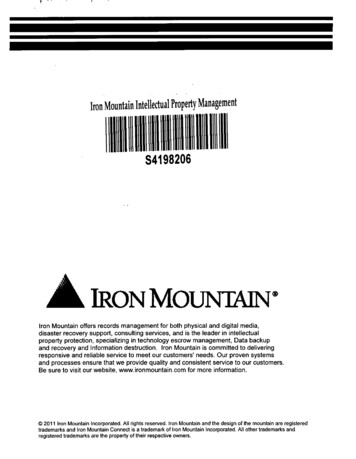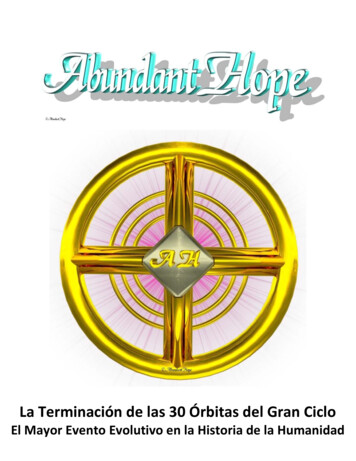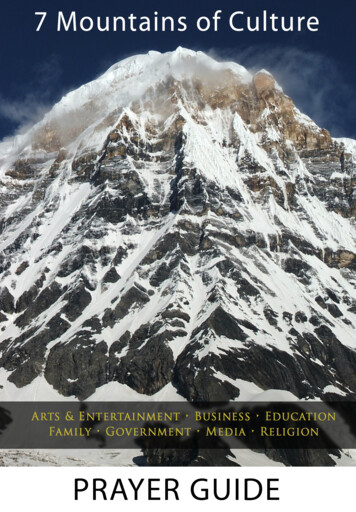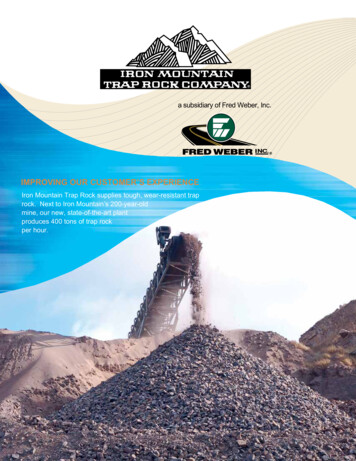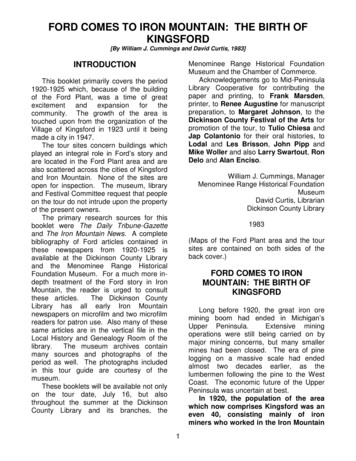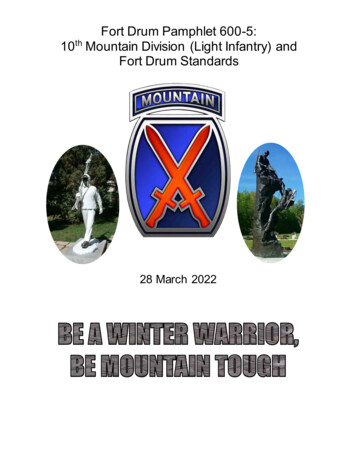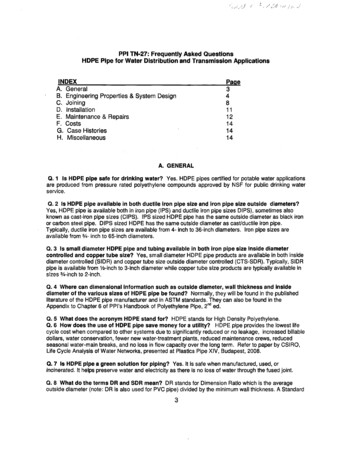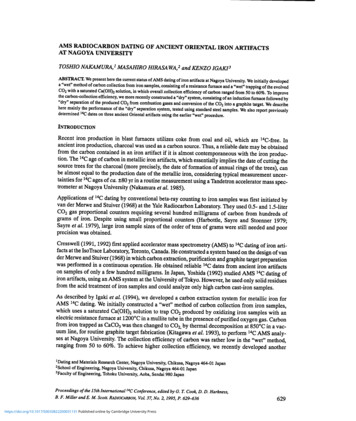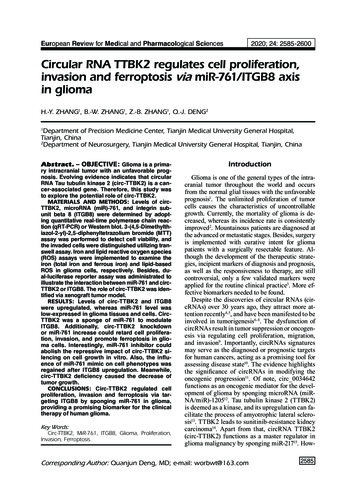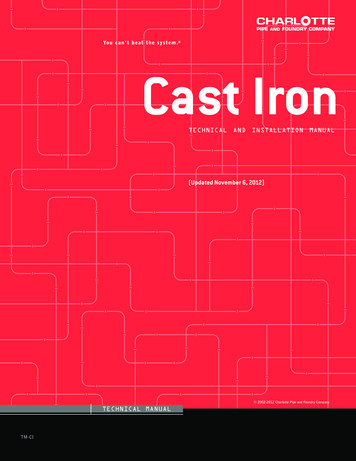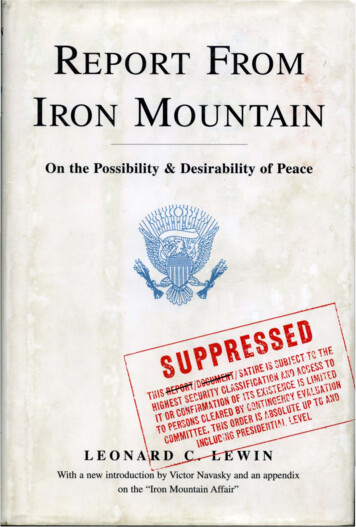
Transcription
REPORT FROMIRON MOUNTAINOn the Possibility & Desirability of Peace
POL ITI CALSC I ENC E /CU R RENTA F FA I RSON REPORT FROM IRON MOUNTAIN"As I would put my personal repute behind the authenticity of thisdocument, so I would testify to the validity of its conclusions. Myreservations relate only to the wisdom of releasing it to an obviously unconditioned public."- lliRSCHELL MCLANDRESS,WASHINGTON POST BOOK WORLD,1967"It is, of course, a hoax-but what a hoax!-a parody so elaborateand ingenious and, in fact, so substantively original, acute, interesting and horrifying, that it will receive serious attention regardless of its origin."-ELLIOT FREMONT-SMITH,NEW YORK TiMES,1967"Fear of the Pentagon, fairly new on the right, is an old companion of the left. A shrewd satire, Report From Iron Mountain waspublished in 1967 to mock delusions of 'wargamers ' . But people continue to copy and circulate it-if it is a government document, it is public property; and if it is copyrighted, that just showshow the government uses its illegal power to suppress informa- .tion."-GARRYWILLS,NEW YORK REVIEW OF BOOKS,1995ISBN 0-684-82390-X520009 780684 82390405961950
u.s. 20.00Can. 27.00Ina tradition of political satire that ranges from A ModestProposal to Dr. Strange love falls the perplexing, ingenious,and ceaselessly curious Report From Iron Mountain.Upon its first appearance in 1967, this best-selling "secretgovernment report" sparked immediate debate among journalists and scholars with its disturbingly convincing claim: a condition of "permanent peace" at the end of the Cold War wouldthreaten our nation's economic and social stability. Althoughfinally identified as an antimilitarist hoax by writer/editorLeonard Lewin, who conceived and launched the book with aconsortium of peace movement intellectuals including futureNation editors Victor Navasky and Richard Lingeman, novel-ist E.L. Doctorow, and economist John Kenneth Galbraith,Iron Mountain would eventually take on a life of its own.Long out of print, the Report suddenly reappeared in"bootleg" editions more than twenty years after the originalpublication. In a manner never foreseen by the book's creators, it was now being read as a "bible" by the militias of theradical right-a bizarre reversal that returns this hauntingsatire to the spotlight and raises uncomfortable questionsabout the changing nature of today's political culture.While the language of the Report appears quite reasonable and even astute, like the "think tank" jargon it lampoons,the book's cumulative logic becomes a journey into the madness of a "value free" rationalism that drives it to outrageousconclusions. What ultimately emerges is a brilliantly rendered(continued on back flap)
(continued from front flap)social commentary that again and again taps a nerve in ournational psyche.When the book fIrst appeared, U.S. News & WorldReport revealed that President Johnson "hit the roof' uponlearning of it "and ordered that the report be bottled up for alltime." Twenty-fIve years later fIlmmaker Oliver Stone wouldextol the "fabled" Report as raising "the key question of ourtime," while journalist and businessman Tony Brown would·excoriate it as "a precursor to The Bell Curve, and . theseminal work on social triage."Exposing fear of the national security state in one era,Iron Mountain now reveals a new fault line of paranoia in ourown time-one that may negate old political categories andexacerbate a new and more significant division between therational and irrational in American politics.This new edition of Report From Iron Mountain featuresan introduction by Victor Navasky, an afterword by LeonardLewin, and a collection of articles, assembled here as "TheIron Mountain Affair," that appeared on the book's originalpublication--each a revealing piece of the still-developingpuzzle that has grown up around one of the most engagingand resilient works of political comment of our time.JACKET DESIGN BY TOM STVANPRINTED IN THE U.S.A.COPYRIGHT 1996 SIMON & SCHUSTER INC.DISTRIBUTED BY SIMON & SCHUSTER INC.
FACTSThe original edition of this book was published in 1967 (duringPresident Johnson’s administration) by Dial Press. Months later,Leonard Lewin stepped forward to assert he was the author and thereport was a hoax. This revised edition bears a copyright notice,Lewin’s name as author, and enough additions that it is easy to becomeconfused. This is a guide. The sections of this edition can be dividedinto two categories: The original book, which appears on pages 1-117. Additions, which appear at the front and back of the book: aForeword, a Background Information section, and a series ofarticles.The purpose of the additions is to convince the reader the Report isa work of fiction. The purpose of this page, which was not part of eitherbook, is to convey a few facts. The original book was published anonymously and without acopyright notice. According to the laws in effect in the United States at that time,no copyright was valid unless asserted at the start of publication.Nonetheless, the Federal Government asserted the opposite inthis case. An author must enforce his or her own copyrights through civillawsuits. Not in this case; the Federal Government defended it.What other individuals have had their copyrights protected bygovernment intervention? The Federal Government ordered Dial Press to stop printing theoriginal edition, print instead an edition with the alleged author’sname and copyright notice, then went to the extreme effort ofconfiscating and destroying the original books then in librariesand private hands. A number survived, perhaps enough thatfurther actions were required to discredit the Report.Two things add argument to the authenticity of the Report. First, theFederal Government’s involvement and actions. Second, the emergenceof a “global” effort to end “Global Warming”. Is Global Warming real,or a false flag operation to justify world government and global taxation?
REPORT FROMIRONMOUNTAINON THE POSSIBILITY ANDDESIRABILITY OF PEACEbyLEONARD C. LEWINWITH AN INTRODUCTION BY VICTOR NAVASKYI ITHE FREE PRESSNEW YORKLONDONTORONTOSYDNEYTOKYOSINGAPORE
CONTENTSCopyright 1996 by Leonard C LewinAll rights reserved,including the right of reproductionin whole or in part in any form.THE FREE PRESSA Division of Simon & Schuster, Inc.1230 Avenue of the AmericasNew York, NY 10020The Free Press and colophon are trademarksof Simon & Schuster Inc.Designed by Michael Mendelsohn of MM Design 2000, IncManufactured in the United States of Americaprinting number10 9 8 7 6 5 4 3 2 1Victor Navasky is copyright holder of the new introductionLibrary of Congress Cataloging-in-Publication DataLewin, Leonard CReport from Iron Mountain: on the possibility and desirability ofpeace! by Leonard C Lewin: with an introd. by Victor Navaskyp cmISBN 0-684-82390-X1. Peace. 2 Economic conversion-United States 3. Economicconversion. 4 . Literary forgeries and mystifications 1 TitleJX1963R46 1996355.02--dc2096-555CIPINTRODUCTION BY VICTOR NAVASKYvForeword1Background Information9Statement by "John Doe"21The Report of the Special Study Group23Letter of Transmittal25Introduction27SECTION 1. Scope of Study31SECTION 2 . Disarmament and the Economy37SECTION 3. Disarmament Scenarios43SECTION 4 . War and Peace as Social Systems47SECTION 5, The Functions of War51SECTION 6 . Substitutes for the Functions of War73SECTION 7,. Summary and Conclusions93SECTION 8,. Recommendations107Notes113AFTERWORD BY THE AUTHOR119Appendixes: "The Iron Mountain Affair"Appendix 1 by John Leo, New York Times125Appendix 2 by Herschel McLandress, Washington PostBook World129Appendix 3 by Eliot Fremont-Smith, New York Times134Appendix 4 from U.S, News and World Report137iii
ivCONTENTSAppendix 5 by Felix Kessler, Wall Street Journal140INTRODUCTIONAppendix 6 by Robert Lekachman, New York Times144BY VICTOR NAVASKYAppendix 7 by Leonard Lewin, New York Times1481995 the Wall Street Journal ran a front-pagestory on Report From Iron Mountain, a book that theIMichiganMilitia and other far-right groups regarded as aN SPRING OF"sort of bible" -along with The Turner Diaries and PatRobertson's New World Order.The Turner Diaries is a fantasy of right-wing revolutionand the New World Order an expose, with antisemiticundertones, of how a cabal of international bankers runsthe world. But Report From Iron Mountain, which purportsto be a suppressed government report, is-as the Journalreported-a 1967 hoax perpetrated by writer LeonardLewin.In fact it was far more than a hoax; it was a satire, aparody, a provocation. Its acceptance by super-patriotsand conspiracy theorists of the far right is roughly akin tothe Irish Republican Army considering Jonathan Swift's AModest Proposal proof that eating babies is official Britishpolicy.The militia connection is only the latest chapter in thebizarre career of an idea that became a surprise best seller.The idea: Put the unpopular subject of conversion from amilitary to peacetime economy on the national agenda.Since I was present at the creation, let me try to explain.In the late 1950s and early 1960s I was editor and publisher of a magazine of political satire called Monocle,which was born at Yale Law School as "a leisurely quarterly of political satire" (that meant we came out twice av
viiREPORT FROM IRON MOUNTAININTRODUCTION BY VICTOR NAVASKYyear), but it eventually graduated, along with the rest ofus. Although we later published one-and only oneissue as what we called a "monthly," by the mid-sixties wecalled ourselves "a radical sporadical," which meant thatwe came out like the United Nations police force-only inemergencies and only when we could meet our financialobligations.Our official line was that "the views of our contributors, no matter how conflicting and contradictory, are theviews of the editors."Unofficially, we were mostly left-liberal Democratswith anarcho-syndicalist pretensions. Typically, we ran theGettysburg address in Eisenhowerese by Oliver Jensen ("Ihaven't checked these figures yet, but eighty-seven yearsago I think it was . "); when J.F.K. failed to integrate publicly assisted housing with "a stroke of the presidentialpen," as he had promised he would, we started the Ink forJack campaign, urging our subscribers to deluge the WhiteHouse with bottles of ink; and we even launched a comicstrip with a peacenik-hero who said the magic equationand turned into a fat superman who looked suspiciouslylike the Hudson Institute's Herman Kahn.For several years we managed to defy George S. Kaufman's adage that "satire is what closes on Saturday night,"but our last regular number appeared in 1965. By thattime, however, our subscription price was "Ten issues for 7.50, or 5 for a lifetime subscription." So in a metaphysical sense one might say that we are still in business, andthis new edition of Report From Iron Mountain is, in a way,evidence that we are.When Monocle ran out of money, as we saw it we hadtwo choices: We could do the honorable thing, and in thegreat tradition of American capitalism declare bankruptcy,go into Chapter 11, and pay our creditors one cent on thedollar. Or, in the jargon of the early sixties, we could sellout. In fact, before we went out of the magazine businesswe ran a symposium where we asked one hundredcelebrities to fill out a one-question questionnaire: "Why ISold Out," which is what we did, or tried to do.We could write our personal books on our own timebut, in line with the non-book fashion of the day, pay ourdebts to society and our creditors from un-books. Thebasic idea was to come up with bestselling book ideas, orrather non-book ideas, that required researchers ratherthan writers, and find trade book publishers willing to payfor and publish them. Then we'd hire researchers toresearch them and split the vast profits among all concerned. Since the idea was to make money and some ofour best, i.e., worst, ideas were calculated to appeal to thelargest possible audience, i.e., the lowest common denominator, we not only had no pride of authorship, we hadshame of authorship, preferring to play an anonymous,behind-the-scenes role. In that capacity we were responsible for over thirty un-books on none of which did we putour name. Now it can be told that although they werepublished under such imprints as Simon & Schuster, Bantam Books, Putnam, Workman, and so forth, Monocle wasthe real perpetrator behind such classics as The Beatles,Words Without Music (transcripts of Beatles press conferences), Barbed Wires, a collection of famous funnytelegrams (Did you know that when Robert Benchleyarrived in Venice he sent a telegram saying, STREETS FULL OFWATER, PLEASE ADVISE?), The Illustrated Gift Edition of TheCommunist Manifesto (the cover blurb was" 'Revolutionary!' V. I. Lenin"), The Algonquin Wits, dictionaries such asDrugs from A to Z, and so forth.But as it turned out we were unsuited to follow thesimple formula we had invented: Have other peopleVI
viiiixREPORT FROM IRON MOUNTAININTRODUCTION BY VICTOR NAVASKYresearch books based on cliched ideas that would appealto the masses, while we clipped coupons. Call it hubris,call it boredom, or call it incompetence, I prefer to thinkthat our instincts were insuffiCiently base. For instance,when a lawyer-friend told us that Delacorte Publishinghad sold on supermarket counters alone more than twomillion copies of a little, 2S-cent chap book called A Wife'SRights, our immediate thought was to produce a quickieon Kid's Rights. But the researcher we recruited claimedthat it was impossible and perhaps even unethical toreduce the complexities of children's rights to horn-booklaw one-liners. She persuaded us that the subject called fora real book and proceeded to research and write it, underthe snappy title Up Against the Law. Of course it receivedrespectful reviews and instead of selling in the millions, itsold in the tens of thousands .Weary of non-books and wary of real books, we missedthe opportunity Monocle had afforded to comment on thepassing scene. And there was much on which to comment.Those were the days of the Vietnam war when our militaryand political leaders kept assuring us that there was '1ightat the end of the tunnel," that our boys "will be home byChristmas." With Grove Press as publisher, we did put outan entire book of quotations by L.B.J., General Westmoreland, and lesser evils predicting the imminent end of thewar. Needless to say, the war-and the predictions-continued long after this particular un-book was published.That book may have been a turning point for us, however. We continued to spawn collections, anthologies, andother ephemera but somehow they got more and moreserious (dare I say distinguished?) and sold fewer andfewer copies. Under our aegis, James Boylan, the formereditor of the Columbia Journalism Review, put together athoroughly scholarly, annotated selection of articles fromwhat was arguably the best newspaper this country everproduced, the old New York World. Two Berkeley grad students collected the most interesting essays written aboutthe free speech movement and what followed, under thetitle Revolution at Berkeley, and Irving Howe wrote a smartand prescient introduction that anticipated the campusturmoils to come in the early seventies.It was in that context that Report From Iron Mountain: Onthe Possibility and Desirability of Peace was born. The yearwas 1966 and one morning the New York Times featured ashort news item about how the stock market had tumbledbecause of what the headline called a "Peace Scare,"The news item had no byline, but it seemed to those ofus around the editors' table in the Monocle office worthy ofJonathan Swift, H. L. Mencken, Mark Twain. Around thetable, in addition to myself were Marvin Kitman andRichard Lingeman. Kitman, our news managing editor,had been Monocle's candidate for president in 1964. He ranin the Republican primary against Barry Goldwater aswhat he called "a Lincoln Republican." Unlike Goldwater,whose platform only went back to McKinley, Kitmanclaimed to be the only real conservative because his platform went back one hundred years and called for unconditional surrender of the South, freeing the slaves and thereinforcement of the garrison at Fort Sumter. Lingeman,Monocle's executive editor, had served as Kitman's "holyghostwriter," and eventually moved on to a distinguishedcareer as Theodore Dreiser's and now Sinclair Lewis'sbiographer and is my colleague at The Nation.We, of course, naively believed that the prospect ofpeace would be as welcome on Wall Street as in Monocle'slow-rent Greenwich Village offices. All of which got usthinking. Suppose the government had appointed a taskforce to plan the transition from a wartime economy and
xiREPORT FROM IRON MOUNTAININTRODUCTION BY VICTOR NAVASKYthe task force concluded that we couldn't afford it becauseour entire economy was based on the preparation for warand without this threat it would collapse? The reporttherefore was suppressed.In the spirit of Mencken's famous hoax about the introduction of the bathtub to the u.s. (he claimed that onlyafter Millard Fillmore introduced one into the WhiteHouse did Americans, who previously regarded them asunsanitary, start to bathe regularly), we decided to publishthe story of the suppression of this report.To give the book credibility we needed an ultrarespectable mainstream publisher, but one with a sense ofhumor and the pluck to pull off a hoax. This publishershould also share our belief in the importance of puttingthe subject of economic conversion from a military to apeacetime economy on the national agenda.Luckily for us the ideal candidate was at hand. Our collection of essays growing out of the free speech movementat Berkeley had been published by Dial Press, whose listincluded such prestigious writers as James Baldwin, Norman Mailer, and Richard Condon. As a result we came toknow Dial's maverick publisher, Richard Baron, and itsimaginative editor-in-chief, author of a little-known novelcalled Welcome to Hard Times, one E. L. Doctorow, whosubsequently came to fame as the author of The Book ofDaniel, Ragtime, and other novels that seemed dedicated tothe proposition that fiction could be a path to deepertruths than non-fiction. Sight unseen, they signed on andproposed listing the book in their catalogue as non-fiction,and not even telling their salesman about the hoax.We had equal luck with our choice of author. We knewthat Leonard Lewin, who had edited an anthology ofpolitical satire (under the pseudonym of L. L. Case), was astudent of the genre. We knew that he cared passionatelyabout issues of war and peace. And his wicked simultaneous parody of the historian Arthur Schlesinger, Jr., andEisenhower speechwriter Emmet Hughes's memoir, TheOrdeal of Power, which Monocle magazine had publishedunder Lewin's title "The Ordeal of Rhetoric," showed himto be a sophisticated observer of what Ike had called inhis farewell speech (written with the help of Hughes), themilitary-industrial complex.There was only one problem. Lewin insisted that hecouldn't write the story of the suppression of the so-calledreport, until there was a report to be suppressed. And so,with the discreet input of his Monocle colleagues and folksranging from Arthur Waskow, then at The Institute forPolicy Studies in Washington (who was at work on whathe called "A History of the Future"); W. H. Ferry of TheCenter for the Study of Democratic Institutions in SantaBarbara, California; John Kenneth Galbraith, who wasback at Harvard after his stint as JFK's Ambassador toIndia; and a small cadre of Monocle interns to track downoriginal sources, Lewin wrote the report. Titled ReportFrom Iron Mountain: On the Possibility and Desirability ofPeace, it was a brilliant imitation of think-tankese renderedin impenetrable, bureaucratic prose, replete with obfuscating footnotes, all of them, except for two trick ones, to realif esoteric sources, in a variety of languages.When we read the report, we all agreed that it had to bepublished in its entirety. Thus the report became the bodyof the book and the narrative of its suppression becamewhat appears in the pages that follow as "Foreword,""Background Information," and "Statement by John Doe."As it happened, our carefully planned cover story (or"legend" as they say in the CLA.) paid off. When JohnLeo, then a reporter for the New York Times, spotted thenon-fiction listing of the Report in Dial's catalogue, hex
xiixiiiREPORT FROM IRON MOUNTAININTRODUCTION BY VICTOR NAVASKYmade the traditional round of calls to determine whether itwas real or a hoax. At Dial he was told if he thought it wasa fraud he should check the footnotes, virtually all ofwhich, of course, checked out. No advance reviewer in thetrade publications had been willing to label it a hoax, andthe State Department's Arms Control and DisarmamentAgency carefully said, "To our knowledge no such specialstudy group ever existed." When he called the WhiteHouse, instead of a denial, Leo got a te-us. (For all the L.B.J.White House knew, the J.F.K. White House had commissioned such a study.) The upshot was that the Times ranLeo's story saying that the possible hoax was a possiblysuppressed report on the front page. The headline, whichitself could have been a parody of Times style, said "Somesee book as hoax/Others take it seriously."Then, John Kenneth Galbraith, who had been writing aseries of spoof articles for Esquire under the pseudonymMark Epernay about a fictitious "psychometrist," Professor Herschel McLandress (creator of the McLandressDimension, a theory about how long people can go without thinking about themselves-e.g., Henry Kissingerachieved a coefficient of 6.0 minutes on the scale), wrote areview in Book World under the name of McLandress. Theprofessor concluded, "As I would put my personal reputebehind the authenticity of this document, so I would testify to the validity of its conclusions. My reservationsrelate only to the wisdom of releasing it to an obviouslyunconditioned public." The review led to speculation thatGalbraith himself had written Report From Iron Mountain.He called a press conference to deny he had anything todo with it. There were only two conceivable authors, hesaid: Dean Rusk or Clare Boothe Luce.A number of people-most of them in government andregular readers of bureaucratese-came to believe theReport was the real thing. Some reviewers praised it as asatire. Transaction magazine devoted the better part of anissue to a sober discussion of the questions the Reportraised. The symposiasts, in addition to editor-in-chief IrvingLouis Horowitz, included Kenneth Boulding, Herb Gans,and other distinguished policy-intellectuals. Most interesting were the reactions of Herman Kahn and HenryKissinger, who took the satire personally and angrily dismissed it as sophomoric and idiotic, and Fletcher Prouty, anational security aide in the Kennedy Administration (themodel for the Donald Sutherland character in Oliver Stone'sJFK) who said he believed it was the real McCoy. In 1972Lewin confessed his authorship in the New York Times BookReview. He had intended, he wrote, "to caricature the bankruptcy of the think-tank mentality by pursuing its style ofscientistic thinking to its logical ends." He defended thehoax technique as the best way to gain attention for thebook and its underlying message.In a weird coda, Lewin discovered in the mid-1980sthat the ultraright Liberty Lobby and others believing thatthe report was a government document, had disseminatedthousands of copies without bothering to request permission and some of these copies were being sold throughLiberty Lobby's hate-filled newspaper, The Spotlight. Hesued and the case was settled out of court, resulting in thewithdrawal of thousands of copies of the bootleg edition,which now reside in Lewin's living room. But well-worncopies continued to circulate along with a six-hour videobased on the book.One might have thought that the hoax, having beenconfessed, proclaimed, and even adjudicated, would, aftertwenty-five years, have been laid to rest. But no, like aradioactive substance, it seemed to have a half-life of its
xivxvREPORT FROM IRON MOUNTAININTRODUCTION BY VICTOR NAVASKYown. On May 9, 1995, the Wall Street Journal ran a frontpage story headlined:budget that undergirds Iron Mountain's premise isn't.When last heard from, the U.s. Senate had approved a 265,3 billion defense bill- 7.5 billion more than the Pentagon and the President had asked for.Paranoid conspiracy theorists now believe that thequashing of the Iron Mountain report is itself a real government conspiracy because they are paranoid and conspiracy theorists. But their perspective can only be reinforcedby the refusal of the government and particularly ourintelligence agencies to release millions of still-classifieddocuments, some of these pre-cold war relics dating backmore than fifty years.For libertarians, who occupy that weird 1990s limbowhere left meets right in their joint distrust of The State,Iron Mountain confirms their belief that too often claims ofnational security are a cloak for government lies, coverups, and bureaucratic disinformation.Indeed, the jilUX neutrality of Iron Mountain's narrativevoice seems to have had the ironic effect of permitting abroad spectrum of constituencies to read their own meanings into Leonard Lewin's text. In this way it may be saidto have separate but equal resonance for military Keynesians who might see it as an "irresponsible"? "sophomoric"? satire and members of the Michigan militia andother groups who might draw on it for a different sort ofammunition.Lewin's skillful parody of think-tankese, the languageof ponderous objectivity, and think-tank-think, whichemphasizes a "value-free" approach to issues of greatmoral moment, underlines the folly of confusing moderation of tone with credibility and of assigning so-calledvalue neutrality a sacrosanct place in public discourse.The Report was a success in that it achieved its mission,which in this case was to provoke thinking about theA Cause for FearThough Called a Hoax'Iron Mountain' ReportGuides Some MilitiasIron Mountain, it seemed, had returned. And now, tothe loonies in the boonies, here was evidence of a government plot so sinister it would make Waco look like a pantyraid. Aux arms, citoyens!So why won't Iron Mountain go away? Perhaps it'spartly because pied piper Lewin, with his perfect pitch,has stumbled on a netherworld for paranoids-the blackhole of government secrecy and deception, whereKennedy assassinationologists today march in lockstepwith white supremacists, neo-Nazis, and militiamen. Byexposing their exaggerated fears and suspicions, he alsotaps into our own unresolved political conflicts.But make no mistake about it. The contradictions incontemporary culture are not confined to paranoids. Thesedays anti-interventionist alumni of the peace movementhave found themselves on the same "side" as isolationistslike Pat Buchanan in opposing U.S. intervention in Bosnia.Ditto civil libertarians and NRA activists in opposing measures like 1995's so-called counter-terrorism bill. IronMountain speaks to a moment when it is unclear whethersuch convergences mean political realignment or simplysignify confusion.Given Report From Iron Mountain's twisted trajectory,one hesitates to draw any "conclusions" from this tale.Here, however, are some interim reflections:The cold war may be over, but the bloated military
xviREPORT FROM IRON MOUNTAINunthinkable-the conversion to a peacetime economy andthe absurdity of the arms race. But it was a failure, giventhat even with the end of the cold war we still have a coldwar economy (which makes the Report all the more relevant today).The Report also raised the perennial question of realityoutdistancing satire. As Lewin later wrote, liThe PentagonPapers were not written by someone like me. Neither wasthe Defense Department's Pax Americana study (how totake over Latin America)."Finally, the fact that today's ultraright conspiracy theorists, reinforced in their paranoia by governmental abuseand secrecy, take Lewin's scenario as seriously as thethink-tankers take themselves is, of course, the scariestproposition of all. Every time Lewin or others in on thehoax confess, the conspiracy theorists regard it as furtherproof of a cover-up.When I wrote about this phenomenon in The Nation Isaid that perhaps the only way to put a stop to this speculation is to tell them: "Guys, you're right! Report From IronMountain is a real document. Remember: You read it herein the pro-Commie, pro-government, pro-Jewish, antiAmerican Nation."But the sad truth may be that the jargonized prose,worst-case scenario thinking, and military value-ladenassumptions that Lewin so artfully skewers are still withus. And if that is true, the joke is not on the Michigan andother militias. It is on the rest of us, and it's no longer sofunny.Victor NavaskyNovember 1995REPORT FROMIRON MOUNTAIN
FOREWORD"JOHN DOE," as I will call him in this book for reasons thatwill be made clear, is a professor at a large university inthe Middle West. His field is one of the social sciences, but Iwill not identify him beyond this. He telephoned me oneevening last winter, quite unexpectedly; we had not beenin touch for several years. He was in New York for a fewdays, he said, and there was something important hewanted to discuss with me. He wouldn't say what it was.We met for lunch the next day at a midtown restaurant.He was obviously disturbed. He made small talk forhalf an hour, which was quite out of character, and I didn'tpress him. Then, apropos of nothing, he mentioned a dispute between a writer and a prominent political familythat had been in the headlines. What, he wanted to know,were my views on "freedom of information"? How wouldI qualify them? And so on. My answers
The original book, which appears on pages 1-117. Additions, which appear at the front and back of the book: a Foreword, a Background Information section, and a series of articles. The purpose of the additions is to convince the reader the Report is a work of fiction. The purpose of this page, which was not part of either
